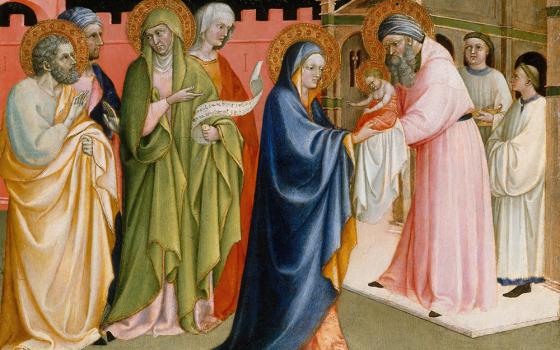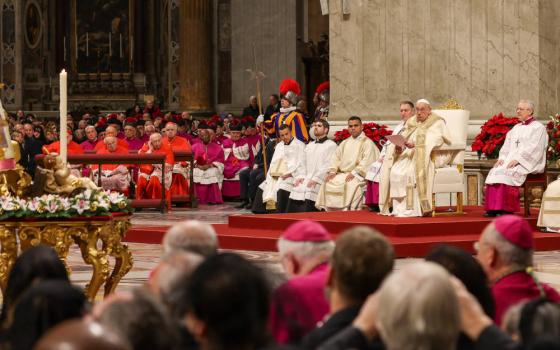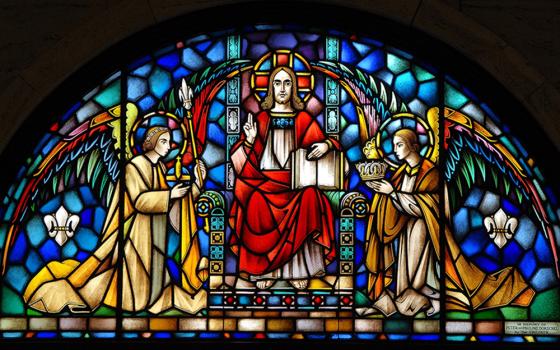A statue of St. Scholastica outside Elizabeth Hall at Benedictine College. (OSV News/Megan Marley)
As a Benedictine woman, it’s no surprise that I love the feast of St. Scholastica. Though we only have one story about her from the Dialogues of Gregory the Great, it is a doozy. In brief: as was their annual custom, Benedict and Scholastica meet between their monasteries one particular year to have a visit. St. Gregory writes: "They devoted the whole day to the praises of God and to holy conversation." They talk into the evening, and then Benedict says it is time to leave. Scholastica asks him to stay so they can keep talking about holy things. He refuses. So she puts her head down on the table and, moved to tears, prays. The skies open up, and there is such a storm that Benedict can’t leave. Gregory concludes that part of the story with the words: "And so it happened that they passed the whole night in vigil and each fully satisfied the other with holy talk on the spiritual life." They go back to their own monasteries, and Scholastica dies three days later.
That’s not much to go on, but the readings for the Mass of the day (Song of Songs 8:6-7 and Luke 10:38-42) beautifully supplement Gregory’s story and can help us deepen our experience of the feast. This is a day when female voices aren’t just present but prominent. As befits this day, the feminine is front and center, with a clarity and volume that I really can’t remember on any other feast or Sunday.
Engaging with the first reading, the Gospel, and the story of our patroness, we hear women. Though I could have told you that "stern as death is love" is a line from the first reading from the Song of Songs for Scholastica, I hadn’t ever spent much time with that reading. But some years ago, when I read all of the Song of Songs in one sitting and looked at some commentaries, I learned plenty. Some people see it as a dialogue between a bride and a groom, read allegorically as a conversation between the church and God. Others see it as snatches of several voices, some male and some female. But whichever model you look at, over two-thirds of the voices are a woman’s. The reading we hear today is the woman speaking – imperatively, emphatically, poetically. In the passage from Luke, Martha and Mary loom large. We don’t actually hear anything Mary says, but we see what she does – and we both hear and see her sister’s reaction. And then there’s Scholastica – the backdrop for it all – the very model of unrepentant surety. So much so that even the venerable Gregory points out that God answers her prayer because it "was she who had the greater love."
One article I read on the Song of Songs discussed several qualities that characterize the female voices in the book. It doesn’t take long to see that those same qualities are shared by our other heroines of the day. All of them are seeking, feeling, articulate and adventurous.
Advertisement
These women seek. Several times throughout the Song of Songs, the woman goes in search of the man without shame and with great eagerness. Sometimes, she finds him, sometimes not. But she is driven enough to keep searching. The Gospel tells us that when Jesus gets to town, Martha goes out to welcome him into the family home. Mary certainly is seeking to learn everything that Jesus had to teach. And though Scholastica seems to have had a much greater grasp on the concept of stability than did Benedict, through daily lived experience with her sisters and holy conversation with her brother, she, too, is seeking a greater understanding of God’s action in her life. In Kathleen Norris’s delightful children’s book, The Holy Twins, a retelling of the Dialogues, Scholastica gently teases her brother: "Isn’t it funny that you had to travel all over to learn some of the things I discovered by staying in one place?"
These women feel. The Song of Songs contains all manner of feeling: desire, confidence, curiosity, frustration, patience, fear, courage, and, as we hear centrally today, love. This woman (or women) is not just living in her head; these are whole human people: minds and bodies, hearts and souls. So are Mary and Martha – so human in their two approaches to the same situation. Mary is seemingly peaceful and content for having chosen the better part. Martha is burdened, anxious, worried, resentful. Gregory never tells us exactly how Scholastica feels, but we can absolutely infer it from what she does: she moves, requests, listens, prays, cries. He does tell us that love was the impetus for it all.
These women speak. The female voices in the Song of Songs discourse beautifully and powerfully about what they know to be true. Today’s reading is one of the best examples: "Deep waters cannot quench love, nor floods sweep it away. Were we to offer all we own to purchase love, we would be roundly mocked." One of the things I appreciate most about Martha is just how real she is. I remember one of my sisters talking many years ago on this feast about how Martha trusts Jesus’s love for her enough to really say what she is feeling. That, too, is powerful. And who has the best line in the rain story? Any Benedictine woman in the world can tell you that. "I asked you, and you wouldn’t listen to me. I asked my Lord, and he listened. Go now, if you can. Leave me and go back to your monastery." It doesn’t get much more articulate than that.
These women risk. All these women did things their culture told them they were not supposed to do. The bride goes out at night looking for the groom more than once in the Song of Songs – and one of those times gets beaten up by the city guards for being out alone after curfew. Martha and Mary break all kinds of rules. They entertain Jesus – a male not related to them – alone in their house. They serve him. Mary sits at his feet – the place of a student, a rabbi’s male student. Scholastica takes on her brother, who was probably counting on her deferring to him – because, as an abbot, who didn’t? – and wins. But then she proves that it wasn’t about the winning at all in how the rest of the night goes – each, as Gregory says, "fully satisfying the other with holy talk on the spiritual life."
Any and all of these women can be excellent guides for us. They show us about faith in the One who is love. They show us about faith in the people around them. And they show us – a lot – about faith in themselves. We probably won’t be able to display all those qualities every day, but they give us something to shoot for. They are a bounteous gift to us. Happy feast day.








